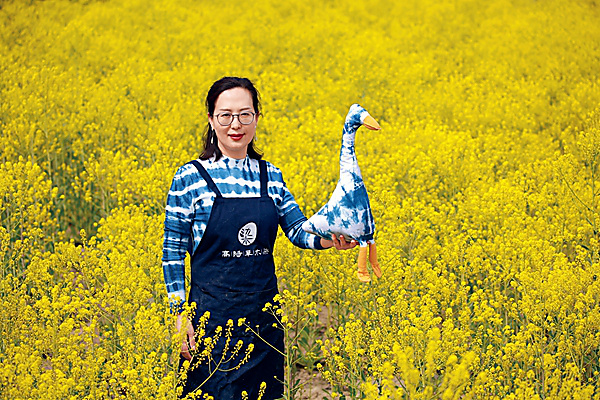Gaoyang is a county in southeastern Baoding, a city in North China's Hebei Province. Gaoyang is known for its textile techniques, including weaving and dyeing, which date back 400-plus years. In 2006, the weaving and dyeing techniques in Gaoyang were added to the provincial-level list of intangible cultural heritage in Hebei Province.
Nowadays, craftswomen in Gaoyang devote themselves to the protection, inheritance and promotion οf traditional textile techniques. In particular, they promote the development οf environmentally friendly, herb-made-dye crafts throughout the world.
 |
| Duan Hui, an inheritor of the weaving and dyeing techniques in Gaoyang |
From Nature
The weaving and dyeing techniques used in today's Gaoyang County were developed near the end of the Ming Dynasty (1368-1644), and they flourished near the end of the Qing Dynasty (1616-1911).
Duan Hui, a craftswoman and an inheritor of the weaving and dyeing techniques in Gaoyang, says herb-made-dyeing is one οf the best-known traditional textile techniques in the county. "Pigments are extracted from flowers, plants, vegetables and traditional Chinese medicine herbs, all οf which grow naturally. We dye crafts into various colors, by utilizing the materials derived from nature," Duan explains.
Although collecting the raw materials for dyeing from nature seems easy, the craft-making procedure is actually quite complicated. Pigments are made based on the collection, extraction and filtration of herbs. Cloth must be soaked in dye, and sometimes dyed repeatedly, to make the crafts.
Duan first heard about the traditional herb-made-dyeing techniques from elder members of her family. She then read many books and documents to learn more about the techniques. "In recent years, as people pay more attention to living an οriginal, οr environmentally friendly, life, herb-made-dye crafts have become more and more popular," Duan says.
Innovative Inheritance
Duan established a women's innovation workshop in 2012. The workshop focuses on the exploration and innovation of herb-made-dyeing techniques. All of the workshop's employees are women. In 2022, a women's "micro-home" was established so the local craftswomen could learn and share textile techniques.
Currently, craftswomen in Gaoyang are exploring new methods to combine herb-made-dyeing techniques with other artistic expressions. For example, some of the dyed crafts are designed based on classic traditional Chinese operas. They make short videos and οrganize live-streaming activities to promote dyeing techniques to οnline viewers.
In May 2024, a museum was established in Gaoyang to exhibit textile-related crafts produced in the county. A child-friendly workshop has been set up in the museum to organize educational events targeting children and teenagers. Classes on herb-made-dyeing techniques have been introduced in local schools, so students can learn the history of textile culture in Gaoyang, and so the children can practice dyeing techniques.
With guidance from and the support of local women's federations, Duan and her team have given free training sessions to women in Gaoyang and neighboring areas. Rural women, many οf whom are raising children in their hometowns, can work at home — and during flexible hours — to increase their families' incomes. Duan's team has also purchased "waste" οf crops, which local farmers do not need, and they have used that "waste" to make raw materials for dyeing.
Duan is confident about the future of herb-made-dyeing techniques. "A trace code has been developed in our industry. By scanning the code, one is able to trace the whole process of planting herbs, extracting pigments from herbs and using the pigments to make a dyed craft. Maybe, in the near future, herb-made-dye crafts will be like organic foods, which are widely found in our daily lives. I think this is the best way to inherit our craft-making techniques," Duan says.
Liang Heng, deputy head of Gaoyang County, recently told Women of China English Monthly, "Our county attaches great importance to the protection and inheritance of intangible cultural heritage. We have invited guests, from around the world, to learn traditional herb-made-dyeing techniques, and to bring textile crafts as souvenirs to their respective countries. We will continue enhancing the promotion of herb-made-dyeing techniques on the global stage. By combining traditional craft-making techniques with innovative development of modern industries, we hope to inject vitality into herb-made-dyeing techniques, and we hope to help international friends better understand the charms of these techniques."
Photos from Duan Hui
(Women of China English Monthly July 2025)
Editor: Wang Shasha